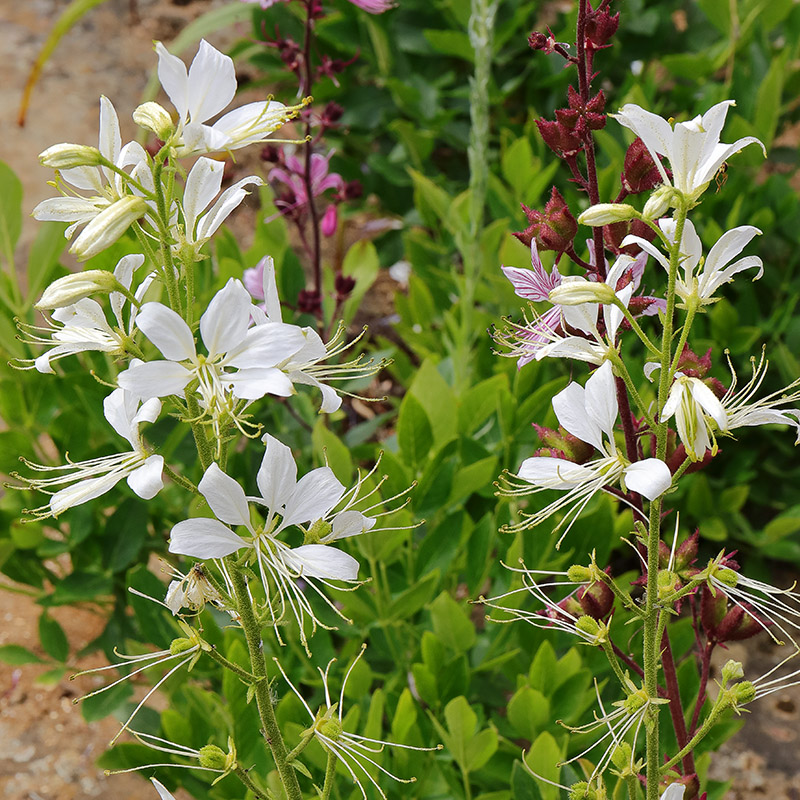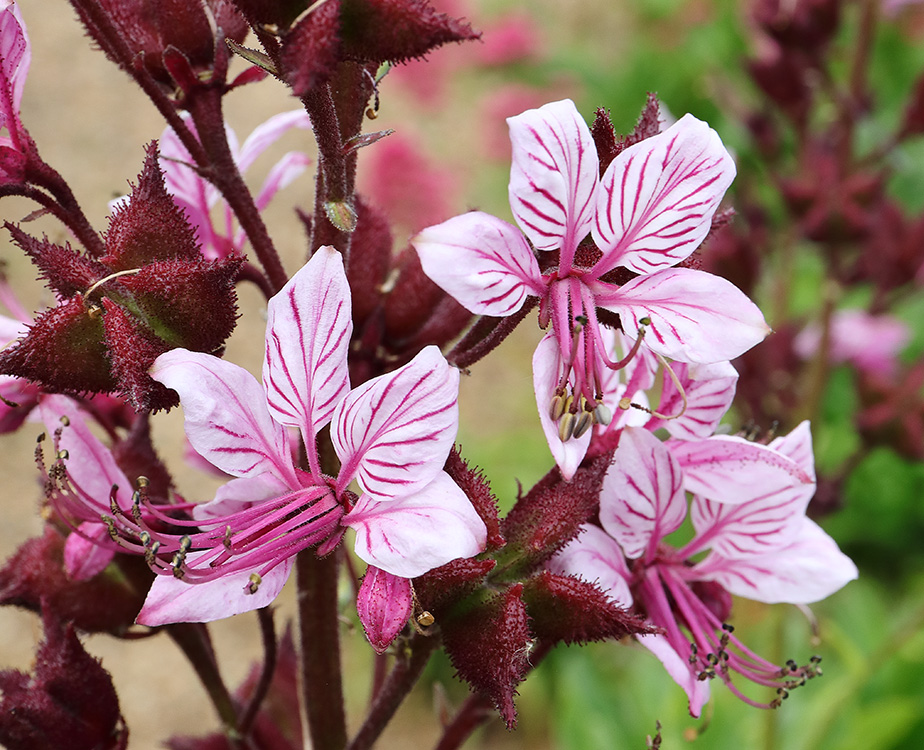NB: A note for WordPress Reader users – you need to click on the title of the post again to see the full photograph. (Otherwise you see just a tiny section!)
This is a plant I’d not seen before – Dictamnus albus (also known as dittany, burning bush, or gas plant). I photographed both the pink and white varieties in a garden I visited recently, then spent a few days trying to figure out what it was. It would have been a good idea to ask the owner of the garden, but she was busy trying to cope with the demand for her excellent coffee and cakes at the time.
Seeing new plants while visiting gardens is fascinating and often gives me ideas for things I’d like to grow. (The ‘want to grow’ list is too long for the garden to accommodate it – a common problem for gardeners!) It’s usually not too difficult to find out the names of plants by using the internet or books. But this one had me stumped for a while.
The flowers seemed like a larger version of gaura flowers, especially in the stamens having such long filaments, but the growth habit was entirely different. The stems of this plant were very upright and individual flowers were held on short stalks, unlike the long, floaty stems of the gaura.
I eventually found a photograph of the plant by doing a Google search for ‘star-shaped seed pod’. There were lots of photos of star anise to wade through before I found one of the Dictamnus. Identified at last!
My search also told me the reason for two of the plant’s common names. ‘Burning bush’ and ‘gas plant’ refer to the fact that the plant emits a volatile oil on sunny days. Apparently this can be set alight without causing any harm to the plant. But it might not be a good idea to try this if the plant is in a garden that you’re visiting!


Rather than gaura, the white flowers bring to my mind one of our native azaleas: also white, with extraordinarily long filaments. I was fascinated by the thought of a flammable plant, but the Missouri Botanical Garden offered guidance in how to enjoy its odd characteristic: “In hot weather, old flowers or seed pods emit a flammable oil which, on a windless summer evening, can be ignited with a match resulting in a brief vapor burn which is harmless to the plant.” On the other hand, that same oil’s said to lead to skin irritation in some people. We have to take the bad with the good (or the odd), I suppose.
LikeLiked by 1 person
There were a lot of these flowers growing where they appeared to have self-seeded amongst the cracks in an old area of paving. I couldn’t help wondering what would have happened if someone lit a match there. Would a big cloud of vapour have ignited? Yikes!
LikeLiked by 1 person
I see why these flowers suggested gaura to you. When I looked up Dictamnus I was surprised to learn it’s in the citrus family. What didn’t surprise me was that Latin dictamnus evolved through Old French and passed into English to become dittany.
LikeLiked by 1 person
Ah, I wondered where the dittany had come from – thanks Steve! I didn’t know it was in the citrus family. Plant families often have surprises!
LikeLike
Ditto.
LikeLiked by 1 person
Those flowers are gorgeous!
LikeLiked by 1 person
Thank you! They really caught my eye when I saw them. 🙂
LikeLiked by 1 person
Very striking!
LikeLiked by 1 person
Thanks Liz! They were very attractive and something new to me.
LikeLiked by 1 person
Thank you Ann for introducing me to this plant 🌿
LikeLiked by 1 person
Glad to make that introduction! It’s an intriguing plant. 🙂
LikeLike
Lovely flowers!
LikeLiked by 1 person
Thanks Steve! These are a bit unusual! 🙂
LikeLiked by 1 person
They are very attractive and no, I hadn’t heard of them either. A tip for you, use Google image search and it allows you to take a photo and searches for similar images, it’s worked well for me several times.
LikeLiked by 1 person
Google images would have been quicker, thanks Jude! 🙂
LikeLiked by 1 person
Very beautiful flowers! I love the plants ‘magical powers’, Ann😉
LikeLiked by 1 person
They could be quite entertaining Indira, especially if the ‘audience’ wasn’t expecting it! Hehe!
LikeLiked by 1 person
You captured such lovely detail in these flowers!
LikeLiked by 1 person
Thank you! I could be tempted to grow them, but I’m running out of space!
LikeLiked by 1 person
☺️
LikeLiked by 1 person
New one on me too, never heard of this before and never seen any. Such a distinctive plant. I hope they don’t spontaneously combust if you come across any more. That would be a worrying thought if you had one.
LikeLiked by 1 person
That would be a worry Jill! But no, I think that the little cloud of vapour needs to be lit with a match. Makes me wonder how this was discovered though!
LikeLike
Yes, that’s an interesting thought.
LikeLiked by 1 person
Hi, it’s lovely to see all the flowers on your blog 😍
LikeLiked by 1 person
Thank you Ai! I’m glad you’re enjoying the flowers here! 🙂
LikeLiked by 1 person
These are so pretty! I’m glad you figured out their identity. I love the satisfaction that comes when I finally find the answer to a question that has been on my mind for a while.
I also loved the photos of your gauras covered in water droplets, even if I’m not quite ready to think of winter yet!
LikeLiked by 1 person
Hehe, no, I really don’t want to think about winter either. Let’s enjoy the summer first!
LikeLiked by 1 person
Yes, let’s!
LikeLiked by 1 person
Gorgeous
LikeLiked by 1 person
Thank you Scarlett! 🙂
LikeLiked by 1 person
You’re welcome 🙂
LikeLiked by 1 person